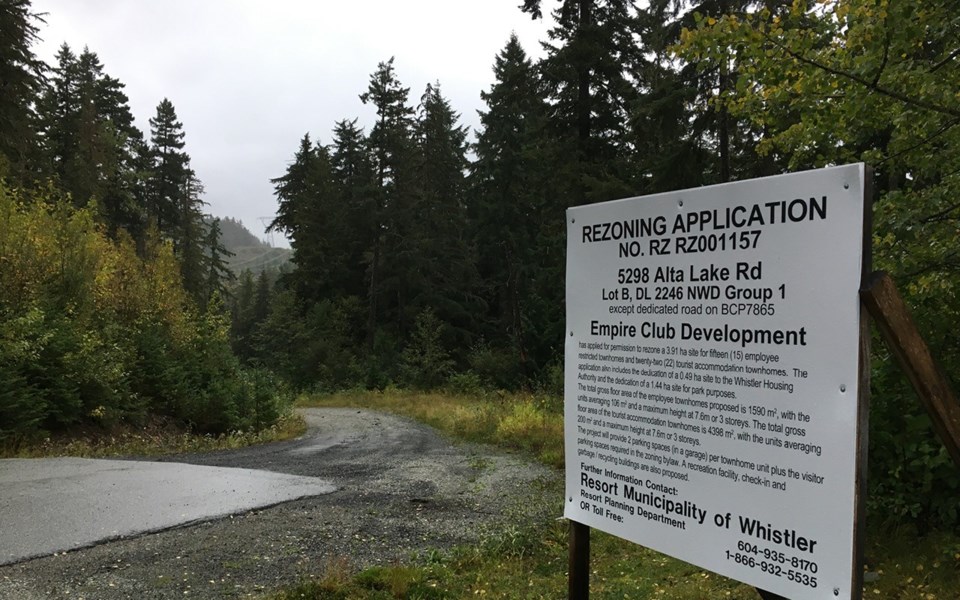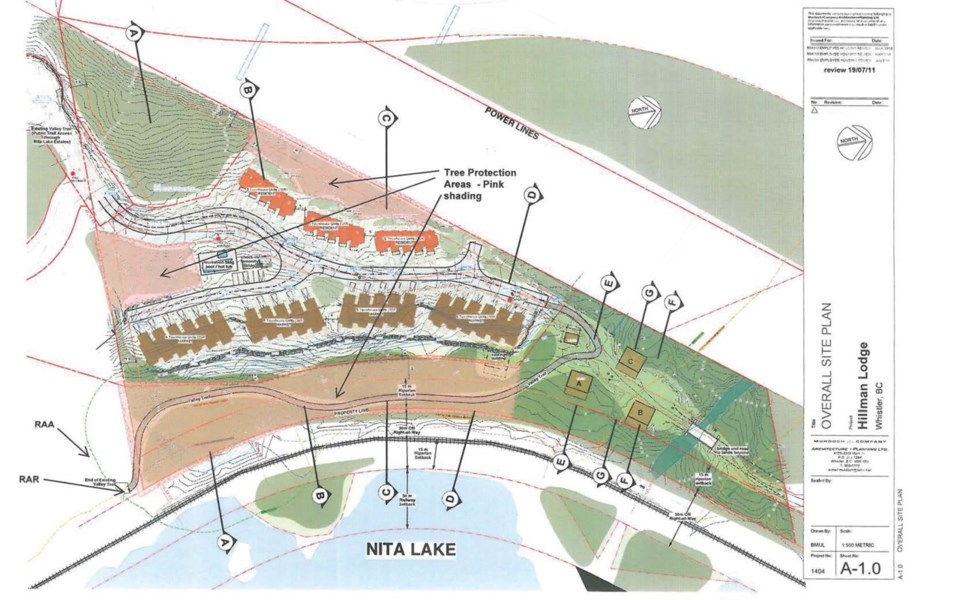
A four-hour council meeting on Tuesday, Sept. 17 was punctuated by three employee-housing projects from private developers: one authorized for further review, one given first and second readings and a third voted down by council in a split decision.
The first, at 5298 Alta Lake Rd., was accompanied by more than a dozen concerned residents who were in attendance to ask questions of mayor and council.
The project was originally submitted under the Resort Municipality of Whistler's (RMOW) private developer employee housing guidelines, but withdrawn before it came to council.
With those guidelines updated in March to allow for limited amounts of new, unrestricted marketing housing, the project was resubmitted with a new concept: 15 new three-bedroom employee-housing-restricted townhomes and 22 three-bedroom market-tourist-accommodation townhomes.

The applicant is Squamish-based Empire Club Development Corp., the principals of which are former Whistler Housing Authority chair Michael Hutchison, Jon Dietrich and Biagio Cusano.
The land—located on the west side of Nita Lake—is currently valued at $10.6 million, and was purchased by its new owners in January 2018.
Among those in attendance for the meeting was Garry Watson, one of Whistler's original council members and one of only 14 people to receive the Freedom of the Municipality.
"I'd like to point out to you that this seems to have risen after the change you made to the guidelines for submissions for private property, which I found very disturbing at the time, as it refers to the proposal [being permitted] a 'limited amount of new unrestricted market accommodation to support the project viability,'" Watson said.
"Now what does viability mean? It means essentially profit, and I'm wondering why that becomes a consideration for council. It certainly got some reaction out of the private property owners, and I'm sure that there had been some significant lobbying to bring about that amendment."
Watson noted that the new application proposes to triple the mass associated with the unrestricted market component allowed under the property's current TA17 zoning.
"That is hardly a limited amount of new," he said.
Other attendees asked questions about protecting Whistler's lakes, the visual and environmental impact of the proposal, the mix of employee housing versus market (and tourist accommodation) units, the traffic impacts and more.
"The provincial government has provided a very clear legislative framework on how we deal with applications that includes a public hearing and a number of different ways for people to participate in that process. This isn't even a part of that legislative process yet," said Mayor Jack Crompton.
"I think we will consider the concerns that are raised by the community, by neighbours, [and] by people wanting to live in Whistler, so we'll be taking seriously all those concerns."
A report to council included a view of the site's historical context courtesy of the Whistler Museum and Archives—the lot was once owned by local sawmill owners Alf and Bessie Gebhart, who constructed the cabin that still stands there today in the mid '40s.
In the mid '60s, Charles Hillman purchased the property, and the cabin became known as the first incarnation of Toad Hall.
Both museum and RMOW staff feel that "the dual narratives of early industry intersecting with early local ski counter culture make this property compelling from a historical perspective," the report to council reads.
As part of its application, Empire proposes parkland dedication on the site, as well as restoration of the existing cabin and relocation to the park to create a historical landmark.
Dedication of a riparian/tree preservation area along the lake foreshore and rail line, as well as dedication of a future employee housing parcel adjacent the existing Nita Lake Resident Housing are also included in the proposal.
After a lengthy discussion, council voted unanimously to authorize further review.
A public information meeting will be held before rezoning bylaws are brought to council.
A public hearing will also be part of the process.
"I want to see some more information. As it sits now, when I look at it ... I think I'll take this deal—the 22 townhouses for 15 employee townhouses, [and] we get a little park, [but] I'm not super interested in the [Tourist Accommodation] zoning," said Councillor Ralph Forsyth.
"So unless I'm convinced otherwise, right now I like the deal, except not TA-zoned. I don't want to pump the brakes on getting employee housing in town."
Crompton offered a similar sentiment, though he disagreed on the value of the deal.
"This is a great location for employee housing, in my opinion, [but] I'm not sure it's a great location for tourist accommodation," he said.
"To be frank I'll be challenged to support this proposal with the current deal. I want to see more employee housing and less market housing."
REVAMPED RAINBOW RIDGE GETS REJECTED
The project at 8975 Highway 99 in Rainbow also returned in a new form, but was eventually voted down in a 4-3 decision.
The application brought forward by Pacific Western Management and Orr Development Corp proposed 36 price-restricted employee townhomes and 24 market townhomes on the site—a drastic change from the 99 apartments and 48 dorm beds in the project's first iteration.
But council's main concern remained the same in both instances: the traffic generated by the proposal.
In its first iteration, council approved consideration of the site under the condition that the proponents get assurance from the province that highway access would be allowed, which it did not get.
The new application proposed a single point of access through an existing strata road—Ski Jump Rise.
Though the applicant believes the new proposal would generate less traffic than the original, and the new traffic generated is "well within acceptable capacity thresholds for the existing Rainbow road network," Coun. Duane Jackson pointed out that several lots in Rainbow are still vacant.
"There's 31 vacant properties so far, so the traffic that the current Ski Jump Rise neighbourhood deals with is only a portion of what's already zoned ... 84 per cent is still to come," Jackson said.
"So if you add on the additional 60 [units], the traffic could potentially increase from what the neighbours understand today by 233 per cent. I don't know if you need a traffic study to recognize that's not an incremental change."
Jackson ultimately voted against authorizing staff to request more information on the proposal, along with Crompton and Couns. John Grills and Arthur De Jong.
The 100-per-cent ownership proposal—which included walking trails, a dog run, a picnic area, connections to local trails and dedication of a community park, as well as provision of a public parking lot with 24 to 30 stalls for trailhead access—was too out of line with the intent of Whistler's updated employee housing guidelines, Grills said.
"When we added the option for a market component to the private employee housing initiative, in my mind at the time ... this was to provide a tool, like a financial lift at a time we were looking at some really expensive costs per square foot," he said.
"Not to the point where it was the numbers we're kind of seeing, where it's half and half."
Crompton agreed, saying the proposal simply didn't meet the definition of limited market development.
"Coun. Grills is right: it was meant to be used as a tool ... not as the centre of a proposal. I am far from a developer but it seems to me that a lot of the requirement for additional funds on this is to actually access a very difficult site," he said.
"I would also say that I remain convinced that access off the highway is critical for the success of this development."
CLOUDBURST DRIVE GETS FIRST READINGS
Lastly, a rezoning proposal by Whistler Sport Legacies (WSL) for employee housing at 1315 and 1345 Cloudburst Dr. in Cheakamus received first and second readings on Sept. 17.
At 1315 Cloudburst, the zoning amendment will add employee housing to the permitted uses on site, increase the maximum permitted gross floor area from 2,500 square metres to 3,900 square meters, and restrict non-employee housing uses to 2,500 square metres of gross floor area.
At 1345, it will add employee housing to the list of permitted uses.
The application proposes 57 apartments, 20 of which (eight one-bedroom and 12 two-bedroom) would be price-restricted employee housing.
Proposed rents are $1,200 per month for a one-bedroom (about 438 square feet) and $2,200 for two-bedroom units (660 square feet).
The remaining units would be used for WSL seasonal staff and shorter-term athlete and coach accommodation.
A housing agreement placed on title at 1345 will include a right of first refusal to fulltime daycare workers and essential services employees as defined by the province.
"I think this is going to fill a lot of boxes that are challenging for us in the community with housing, and it comes to us without a huge investment," Grills said.
"So this is great to see, and it's one more step to working towards getting more employees in secure housing."



